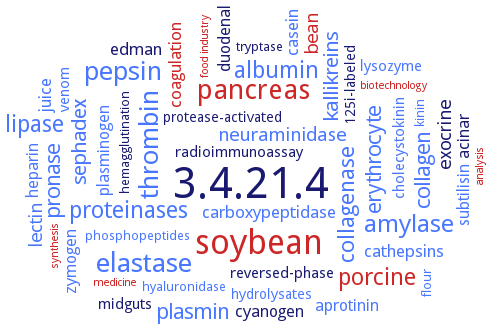3.4.21.4: trypsin
This is an abbreviated version!
For detailed information about trypsin, go to the full flat file.
Reaction
preferential cleavage: Arg-/-, Lys-/-
=
Synonyms
acrosin, alpha-trypsin, anionic salmon trypsin, anionic trypsin, Anionic trypsinogen, AST, aT-I, aT-II, Atlantic cod trypsin I, beta-trypsin, BPT, Brain trypsinogen, BT, cationic trypsin, Cationic trypsinogen, cocoonase, CST, EC 3.4.4.4, EFE, EG-T, fibrinolytic enzyme, gamma-trypsin, GM-T, group III trypsin, mesotrypsin, Mesotrypsinogen, midgut-specific serine protease 1, midgut-specific serine protease 2, More, p23, parenzyme, parenzymol, PPT, pro23, pseudotrypsin, SET, SGT, sperm receptor hydrolase, ST-1, ST-2, ST-3, TI, TIIA, TIII, TLE, TLE I, TLE II, TR-P, TR-S, tripcellim, TRP, Try, TRY-3, TryI, TryII, TryIII, TRYP, trypsin 1, trypsin 3A1, trypsin 4, trypsin A, trypsin B, trypsin I, trypsin IV, trypsin type III, trypsin Y, trypsin-1, trypsin-2, trypsin-3, trypsin-4, trypsin-like enzyme, trypsin-like serine proteinase, tryptar, tryptase, trypure, TrypZean, type I trypsin, type IX pancreatic trypsin
ECTree
General Stability
General Stability on EC 3.4.21.4 - trypsin
Please wait a moment until all data is loaded. This message will disappear when all data is loaded.
Please wait a moment until the data is sorted. This message will disappear when the data is sorted.
0.5 mM CaCl2 stabilizes the activity, especially at acidic pH-values
-
a fibronectin type III-like peptide from aqueous extract of human placenta, used as a licensed drug for wound healing, tightly complexes the enzyme and protects it against autodigestion. Trypsin retains 40% of activity at constant level between 20 and 26 days in presence of the extract against complete inactivation in its absence. The peptide-trypsin complex is dissociated in presence of high concentration of substrates
-
aggregated trypsin-containing nanofibers demonstrate excellent enzymatic activity (300 times higher than monolayered nanofibers), long-term stability (i.e. negligible loss of activity over 1 year), and a high resistance to proteolysis by other proteases (such as alpha-chymotrypsin)
-
autolysis is a contributing factor in the stability of trypsin I
-
benzamidine minimizes the autolysis of trypsin
-
Ca2+ stabilizes the enzyme
-
Ca2+ stabilizes the purified enzyme
-
decreasing dielectric constant results from the stabilization of electrostatic energy for the formation of an oxyanion hole, and this stabilization is caused by the increase of electrostricted water around the charged tetrahedral transition state. The control of the solvent dielectric constant can stabilize the tetrahedral transition state, and this lowers the activation energy
-
denaturation in neutral solution: denaturation of alpha-trypsin is a strict second-order reaction, denaturation of beta-trypsin is not a pure second-order reaction at the same pH. Ca2+ retards the rate of beta-trypsin denaturation to a greater extent than that of alpha-trypsin. Denaturation of immobilized trypsin in alkaline solution is a first-order reaction, Ca2+ does not affect the rate of trypsin denaturation in alkaline solution
-
enhancement of stability and aggregation of proteins in the presence of low concentrations of polydocanol
-
enzyme immobilization in the layer structure of polyelectrolyte microcapsules leads to activity reduction of up to 90%
-
enzyme immobilized on Sepharose has higher thermal stability than the wild-type enzyme, enzyme immobilized on porous glass loaded with isothiocyanate propyl groups has the same thermal stability as the wild-type enzyme, enzyme immobilized on DEAE-Sephadex has lower thermal stability than the wild-type enzyme
Cambarus affinis
-
free trypsin shows rapid autolysis under common working conditions (37°C, pH 8.0), chitosan-coated maghemite nanoparticles may serve as a carrier for immobilization of raffinose-modified trypsin exhibiting the highest thermostability and being applicable for rapid protein digestion at 37-55°C
-
in the so-called autolysis loop and shows no degradation after 96 h of incubation at 37°C
isozyme TryIII displays high resistance against autoproteolysis with a low susceptibility of the N-terminal domain towards autolysis
-
modification by biacetyl does not improve thermostability of SGT
no loss of activity upon modification up to 75-85% with monomeric glutaraldehyde, polymeric glutaraldehyde, oxidized sucrose and oxidized sucrose polymers. Modified trypsin resists exposure to 8 M urea in the presence and absence of 5 mM 2-mercaptoethanol, native enzyme loses its activity in 20 and 120 min
-
radiation damage, a higher amount of absorbed dose and high beam intensity yield more radiation damage such as broken disulfide bonds, it appears that high intensity and not only the total X-ray dose is most harmful to protein crystals
significant stabilization in the neutral and alkaline range by 15 mM Ca2+
-
sol-gel-entrapped trypsin activity is stable when sol-gel glasses are incubated at 25°C, pH 7.5, for several months. Trypsin immobilized in sol-gel glass by surface adsorption and incubated under the same conditions overnight is completely autodigested
-
stable in 70% methanol at 0°C and below, pH 6.4
-
Streptomyces erythraeus trypsin is resistant to autolytic degradation due to the absence of an arginine or lysine residue
the enzyme activity is completely stable in presence of detergents, overview
-
the immobilized trypsin reactor on porous polymer monoliths maintains its activity for at least 80 h with a slight decrease from 80 to 67% in sequence coverage for bovine serum albumin during this time period
-
Ca2+ stabilizes

-
radiation damage, a higher amount of absorbed dose and high beam intensity yield more radiation damage such as broken disulfide bonds, it appears that high intensity and not only the total X-ray dose is most harmful to protein crystals

salmon
-
radiation damage, a higher amount of absorbed dose and high beam intensity yield more radiation damage such as broken disulfide bonds, it appears that high intensity and not only the total X-ray dose is most harmful to protein crystals




 results (
results ( results (
results ( top
top





